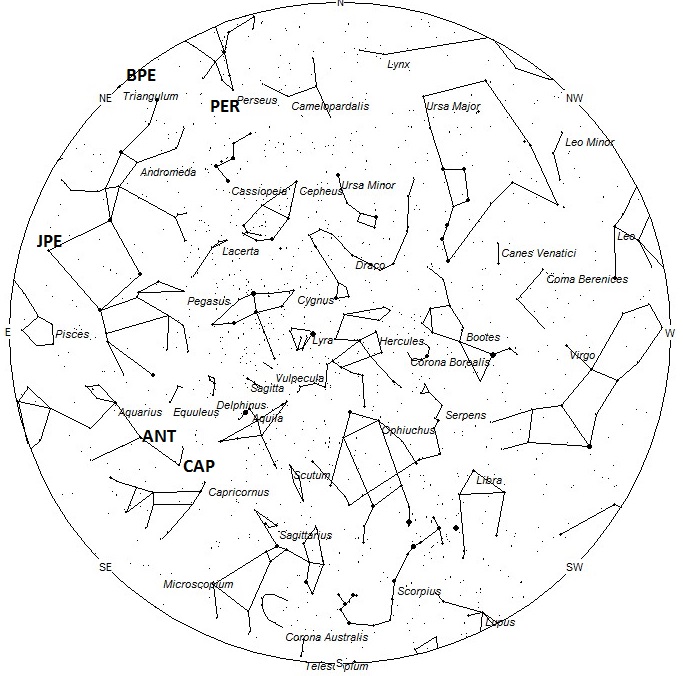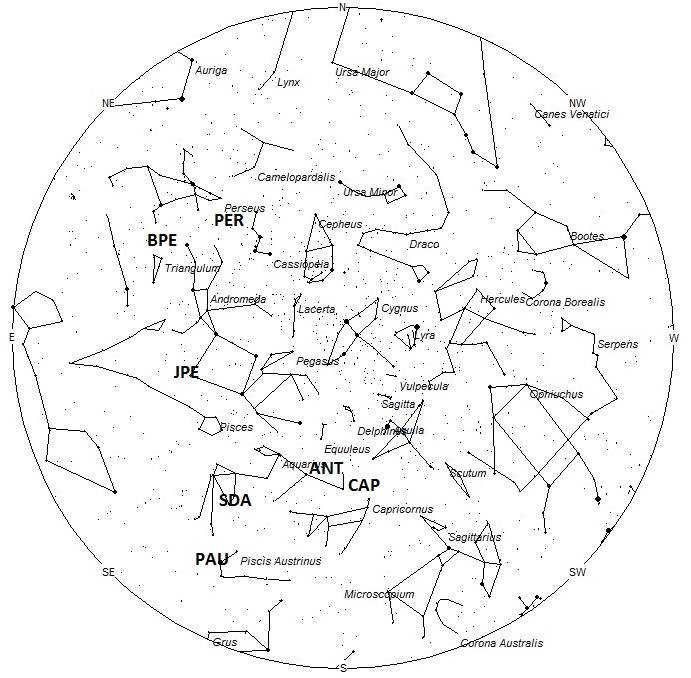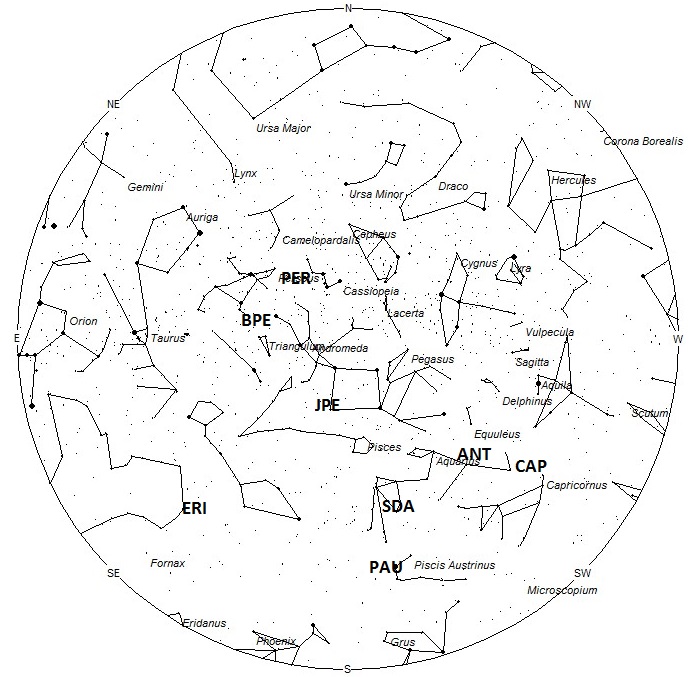
Meteor activity kicks into high gear in August as seen from the northern hemisphere. The main reason for all this activity is the Perseid shower that peaks on August 12th. This shower is active most of the month and remains above the level of the sporadic background for a week centered on August 12th. The sporadic activity is also near maximum as seen from the northern hemisphere and is now more than double the rates from just three months ago. As seen from southern hemisphere, meteor rates are still decent but falling rapidly. The sporadic rates continue their downward slide and the Perseid radiant does not rise high into the sky as seen in the southern hemisphere. So rates for the Perseids are greatly reduced when compared to those seen from the northern hemisphere.
During this period the moon reaches its new phase on Tuesday August 2nd. At this time the moon will lie near the sun and will be invisible at night. This weekend the slender waning crescent moon will rise just before dawn and will not interfere with viewing meteor activity. The estimated total hourly meteor rates for evening observers this week is near 5 for observers located in the northern hemisphere and 4 for observers located in tropical southern locations (25S). For morning observers the estimated total hourly rates should be near 25 for observers located in the northern hemisphere and 27 for observers located in tropical southern locations (25S). The actual rates will also depend on factors such as personal light and motion perception, local weather conditions, alertness and experience in watching meteor activity. Note that the hourly rates listed below are estimates as viewed from dark sky sites away from urban light sources. Observers viewing from urban areas will see less activity as only the brightest meteors will be visible from such locations.
The radiant (the area of the sky where meteors appear to shoot from) positions and rates listed below are exact for Saturday night/Sunday morning July 30/31. These positions do not change greatly day to day so the listed coordinates may be used during this entire period. Most star atlases (available at science stores and planetariums) will provide maps with grid lines of the celestial coordinates so that you may find out exactly where these positions are located in the sky. A planisphere or computer planetarium program is also useful in showing the sky at any time of night on any date of the year. Activity from each radiant is best seen when it is positioned highest in the sky, either due north or south along the meridian, depending on your latitude. It must be remembered that meteor activity is rarely seen at the radiant position. Rather they shoot outwards from the radiant so it is best to center your field of view so that the radiant lies at the edge and not the center. Viewing there will allow you to easily trace the path of each meteor back to the radiant (if it is a shower member) or in another direction if it is a sporadic. Meteor activity is not seen from radiants that are located far below the horizon. The positions below are listed in a west to east manner in order of right ascension (celestial longitude). The positions listed first are located further west therefore are accessible earlier in the night while those listed further down the list rise later in the night.
These sources of meteoric activity are expected to be active this week.
The alpha Capricornids (CAP) are active for over a month lasting from July 5 through August 9. Unlike most showers, the Alpha Caps have a plateau-like maximum with maximum activity lasting from July 25-30. Hourly rates this week should be 2-3, no matter your location. The radiant is currently located at 20:28 (307) -09. This area of the sky is located in southeastern Aquila, 5 degrees northeast of the 4th magnitude star known as Algedi (Alpha Capricornii). The radiant is best placed near 0100 local daylight time (LDT) when it lies on the meridian and is highest in the sky. With an entry velocity of 22 km/sec., the average Alpha Capricornid meteor would be of slow velocity.
The center of the large Anthelion (ANT) radiant is currently located at 21:20 (320) -14. This position lies in northwestern Aquarius, 2 degrees northwest of the 4th magnitude star known as Sadalsuud (beta Aquarii). These meteors may be seen all night long but the radiant is best placed near 0200 LDT when it lies on the meridian and is positioned highest in the sky. Due to the large radiant area, meteors from this source may also appear to radiant from the constellation of Microscopium, southeastern Aquila, western Aquarius, western Piscis Austrinus, and eastern Sagittarius as well as Capricornus. Rates at this time should be near 1 per hour as seen from the northern hemisphere and 2 per hour as seen from south of the equator. With an entry velocity of 30 km/sec., the average Anthelion meteor would be of slow velocity.
The delta Aquariids (SDA) are still producing good activity from a radiant located at 22:52 (343) -16. This position is located in southwestern Aquarius, just northwest of the third magnitude Delta Aquarii. Hourly rates this weekend will range from 5 per hour as seen from mid-northern latitudes to 10 per hour visible in southern tropical latitudes. The radiant rises near 2200 (10pm) LDT for observers located in the mid northern latitudes, but is best placed near 0300 LDT, when it lies highest in the sky. With an entry velocity of 42 km/sec., most activity from this radiant would be of average velocities.
The Piscids Austrinids (PAU) are a minor shower not well seen from the northern hemisphere. This radiant is active from July 15 through August 10. Maximum activity occurred on July 27th when the zenith hourly rate (ZHR) may have reached five. These rates are only seen from the southern hemisphere where the radiant passes overhead. From mid-northern latitudes, rates of one per hour at maximum are usually seen. The radiant is currently located at 23:04 (346) -30. This position lies in eastern Piscis Austrinus, just east of the bright first magnitude star Fomalhaut (Alpha Piscis Austrinus). The radiant is best placed near 0300 LDT, when it lies highest in the sky. With an entry velocity of 35km/sec., most activity from this radiant would be of average velocities.
The last of the July Pegasids (JPE) are expected this week from a radiant located at 00:20 (005) +16. This area of the sky is located in western Pisces, just northeast of the 3rd magnitude star known as Algenib (Gamma Pegasi). This area of the sky is best seen during the last dark hour before dawn when the radiant lies highest in a dark sky. Maximum activity occurred on July 10th so rates this weekend are expected to be near less than 1 per hour no matter your location. With an entry velocity of 68 km/sec., the average meteor from this source would be of swift velocity.
The Perseids (PER) are active from a radiant located at 02:04 (031) +55. This area of the sky lies in the northwestern Perseus, 5 degrees west of the 4th magnitude star known as Miram (eta Persei). This area of the sky is best seen during the last dark hour before dawn when the radiant lies highest in a dark sky. Since the maximum is still 2 weeks away, rates are expected to be near 5 per hour as seen from the northern hemisphere and 2 per hour as seen from south of the equator. With an entry velocity of 61 km/sec., the average Perseid meteor would be of swift speed.
The eta Eridanids (ERI) were discovered by Japanese observers K. Ohtsuka, T. Tanigawa, H. Murayama, and I. Hasegawa. These meteors are active from July 31st through August 17th and may be responsible for many of the meteors reported from the Cetus/Eridanus area during the Perseid maximum. Maximum activity occurs on August 5th when hourly rates may reach 2 per hour, no matter your location. The radiant is currently located at 02:24 (036) -14. This position actually lies in southeastern Cetus, 5 degrees west of the 4th magnitude star known as Al Sadr al Ḳaiṭos IV (Pi Ceti). Current rates are expected to be less than 1 per hour no matter your location. The radiant is best placed during the last hour before the start of morning twilight when it lies highest in a dark sky. With an entry velocity of 66 km/sec., most activity from this radiant would be swift.
The beta Perseids (BPE) are active from July 24th through August 20th with maximum activity occurring on August 7th. The radiant is currently located at 02:28 (037) +39. This position actually lies in eastern Andromeda, 5 degrees southeast of the famous bright double star known as Almach (Gamma Andromedae). Current rates are expected to be less than 1 per hour no matter your location. The radiant is best placed during the last hour before the start of morning twilight when it lies highest in a dark sky. With an entry velocity of 68 km/sec., most activity from this radiant would be swift. This source was previously listed as the alpha Triangulids (ATR)
As seen from the mid-northern hemisphere (45N) one would expect to see approximately 12 sporadic meteors per hour during the last hour before dawn as seen from rural observing sites. Evening rates would be near 4 per hour. As seen from the tropical southern latitudes (25S), morning rates would be near 9 per hour as seen from rural observing sites and 2 per hour during the evening hours. Locations between these two extremes would see activity between the listed figures.
The table below presents a list of radiants that are expected to be active this week. Rates and positions are exact for Saturday night/Sunday morning except where noted in the shower descriptions.
| SHOWER | DATE OF MAXIMUM ACTIVITY | CELESTIAL POSITION | ENTRY VELOCITY | CULMINATION | HOURLY RATE | CLASS |
|---|---|---|---|---|---|---|
| RA (RA in Deg.) DEC | Km/Sec | Local Daylight Saving Time | North-South | |||
| Alpha Capricornids (CAP) | Jul 26 | 20:28 (307) -09 | 22 | 01:00 | 2 – 3 | II |
| Anthelions (ANT) | – | 21:20 (320) -14 | 29 | 02:00 | 1 – 2 | II |
| Delta Aquariids (SDA) | Jul 28 | 22:52 (343) -16 | 42 | 03:00 | 5 – 10 | I |
| Piscids Austrinids (PAU) | Jul 27 | 23:04 (346) -30 | 35 | 03:00 | <1 – 1 | II |
| July Pegasids (JPE) | Jul 10 | 00:20 (005) +16 | 68 | 04:00 | <1 – <1 | IV |
| Perseids (PER) | Aug 12 | 02:04 (031) +55 | 61 | 06:00 | 5 – 2 | I |
| Eta Eridanids (ERI) | Aug 05 | 02:24 (036) -14 | 66 | 06:00 | <1 – <1 | IV |
| Beta Perseids (BPE) | Aug 07 | 02:35 (039) +39 | 61 | 06:00 | <1 – <1 | IV |
 American Meteor Society
American Meteor Society



Robert,
Love your article on Meteors!
Sunday about 1 a.m four of us were laying on our dock by the water on Loon Lake in Townsend Wi. looking at the sparkling stars, when all of a sudden from one side of the lake, right over our heads shot a meteor, all the way to the other
side of the lake. It was so bright and went from a reddish ball to a yellow orange then the tail was white, it made a very high pitched whistle and low woosh sound, lasted only about 2-3 seconds and then was done. It seemed so close that we wondered if it was going to crash down somewhere. Then 2 more small ones shot over way in the sky. What an awesome thing to witness, we all will never forget that night.
I saw a meteor around 3:30am today, August 7, 2016. I was standing on my balcony on the phone when a huge, extremely fast moving, white hot fireball flew over my building and looked like it was going to crash in the tree tops here in Park Forest, Illinois where I live. I listened for a crash, but I never heard anything which was amazing because it was so low over my home and the trees. I’m still a little shocked. I was in the Navy for 12 years and I have witnessed a multitude of things that one can only see from the middle of the seas, but never, ever witnessed anything like this before.